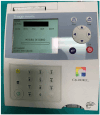Quantification of Myocardial Biomarkers in Sudden Cardiac Deaths Using a Rapid Immunofluorescence Method for Simultaneous Biomarker Analysis
- PMID: 39857776
- PMCID: PMC11760892
- DOI: 10.3390/biomedicines13010193
Quantification of Myocardial Biomarkers in Sudden Cardiac Deaths Using a Rapid Immunofluorescence Method for Simultaneous Biomarker Analysis
Abstract
Background/objectives: Differential diagnosis of sudden cardiac death (SCD) remains challenging, particularly in cases lacking evident structural abnormalities. Cardiac markers have been proposed as useful tools for this differentiation in forensic contexts. However, key issues include the influence of postmortem interval (PMI) on marker stability and the limitations of traditional approaches that focus on pericardial fluid, which requires invasive sampling compared to peripheral blood. This study aimed to evaluate the potential of cardiac markers in peripheral blood for diagnosing SCD, addressing methodological concerns related to PMI, hemolysis, and sample handling.
Methods: This study analyzed 5 cardiac markers (creatine kinase-MB [CK-MB], myoglobin, troponin I [TnI], BNP, and D-dimer) in peripheral blood samples from 42 autopsied cadavers, divided into an SCD group and a control group. Marker levels were quantified using immunofluorescence, with cases meticulously selected to exclude confounding factors such as chronic diseases, pulmonary thromboembolism, and drowning. The study also accounted for potential degradation due to PMI, and evaluated the accuracy of point-of-care testing (POCT) in forensic samples.
Results: The study identified statistically significant differences in myoglobin and TnI levels between the SCD group and the control group, though myoglobin's diagnostic reliability remains limited due to its lack of specificity for myocardial injury. TnI emerged as a more robust marker for SCD. Contrary to prior concerns, PMI showed no significant correlation with marker levels in samples handled without freeze-thaw cycles. Issues related to hemolysis were addressed, and no significant effects were observed from resuscitation maneuvers.
Conclusions: This study supports the potential use of cardiac markers, particularly TnI, in peripheral blood for postmortem SCD diagnosis, emphasizing the importance of rapid and systematic analysis to minimize hemolysis-related variability. While further validation is needed to confirm these findings, this approach offers a less invasive, economical, and practical method for forensic investigations.
Keywords: cardiac markers; forensic sciences; sudden cardiac deaths; troponins.
Conflict of interest statement
The authors declare no conflicts of interest.
Figures






Similar articles
-
Some possibilities in the diagnosis of early acute ischaemic changes in the heart muscle in sudden death.Soud Lek. 2010 Jul;55(3):32-5. Soud Lek. 2010. PMID: 20942243
-
Cardiac biomarkers in blood, and pericardial and cerebrospinal fluids of forensic autopsy cases: A reassessment with special regard to postmortem interval.Leg Med (Tokyo). 2015 Sep;17(5):343-50. doi: 10.1016/j.legalmed.2015.03.007. Epub 2015 Apr 30. Leg Med (Tokyo). 2015. PMID: 26052007
-
The use of cardiac troponin T (cTnT) in the postmortem diagnosis of acute myocardial infarction and sudden cardiac death: A systematic review.Forensic Sci Int. 2018 Nov;292:27-38. doi: 10.1016/j.forsciint.2018.09.002. Epub 2018 Sep 17. Forensic Sci Int. 2018. PMID: 30269044
-
Use of Cardiac Injury Markers in the Postmortem Diagnosis of Sudden Cardiac Death.J Forensic Sci. 2017 Sep;62(5):1332-1335. doi: 10.1111/1556-4029.13397. Epub 2017 Jan 23. J Forensic Sci. 2017. PMID: 28111741
-
Serum markers in the emergency department diagnosis of acute myocardial infarction.Emerg Med Clin North Am. 2001 May;19(2):321-37. doi: 10.1016/s0733-8627(05)70186-3. Emerg Med Clin North Am. 2001. PMID: 11373981 Review.
References
Grants and funding
LinkOut - more resources
Full Text Sources
Research Materials
Miscellaneous

